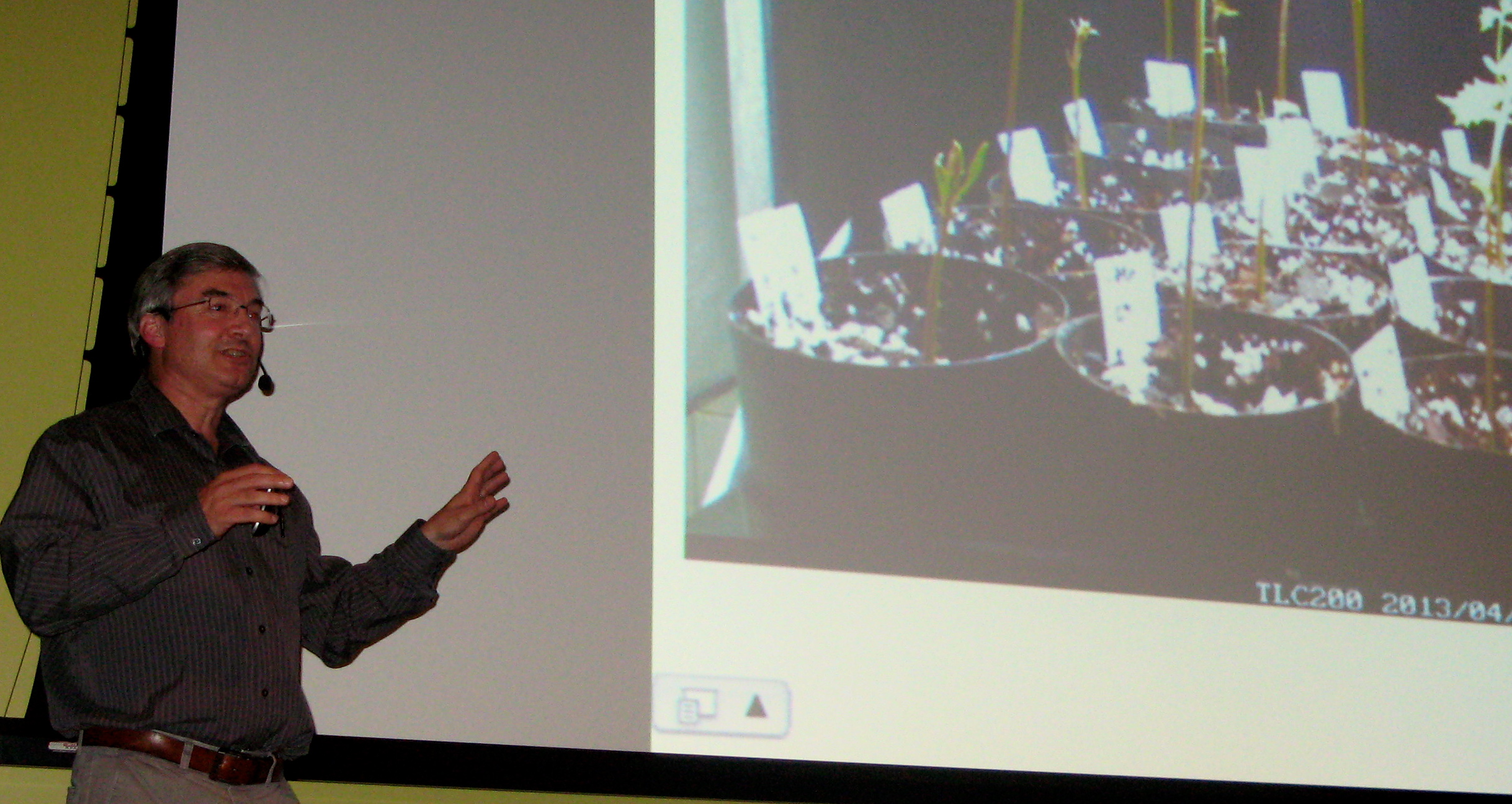Recent Headlines

American Chestnuts: 300 Learn about ‘Return of the King’
More than 300 alumni, faculty, students, and community members filled the Gateway Center Oct. 10 to hear Dr. William A. Powell discuss the past, present and future of the American chestnut tree. Powell's lecture, "Return of the King: Restoring the American Chestnut Tree," presented the use of biotechnology tools to aid in reversing the near disappearance of American chestnut trees due to because of chestnut blight.
Powell, the director of the Council on Biotechnology in Forestry and a professor in ESF's Department of Environmental and Forest Biology, has collaborated with Dr. Charles Maynard of the Department of Forest and Natural Resources Management since the early 1990s. Over the years, Powell's team has had more than 60 researchers working on ways to develop a blight-resistant American chestnut tree.
At one time the most abundant tree in the eastern United States forest, with historic, economic and ecosystem values, the American chestnut tree has seen a sharp decline since the blight was discovered in New York City early in the 20th century. The audience gasped when Powell showed photographs of the "giants of Eastern forests," massive chestnut trees from the late 1800s.
The forests began to change, however, after an exotic pathogen from Asia, a fungus called Cryphonectria parasitica, was discovered in the United States. Within 50 years, that fungus killed between 3 and 5 billion chestnut trees, according to Powell. The chestnut tree was essentially lost, he said, since the mature, larger trees simply no longer exist. "It's not extinct. It's just functionally extinct," he said.
Powell is involved with a transgenic program to enhance blight resistance. Using a natural genetic engineer called Agrobacterium tumefaciens, bacteria that moves genes around in plants, scientists can put in just a few genes at a time, said Powell. Scientists have been using this to move the desired genes from Chinese chestnut trees to American chestnut trees. "We actually put the genes into the bacteria. It puts the gene in the plant for us," said Powell. "What we are actually doing is making a very small change."
Scientists can also use genes from other plants, such as oxalate oxidase, which comes from wheat. "When you go and get your snacks back there, you're going to be eating this gene," joked Powell, referring to the reception held after the lecture. The gene detoxifies the tree by stopping the development of oxalic acid, which is produced by the fungus that kills the tree. With the added genes, the trees are able to defend themselves against the fungus.
Scientists then go through a plant tissue culture and transformation process that involves multiplying embryos and regenerating them into shoots to be rooted and then acclimated to be planted. The entire process can take between 18 to 24 months though recently Powell's team has gotten the process down to 12 months or less. There are currently more than 1,000 transgenic trees in the field for testing, according to Powell.
The transgenic trees show enhanced blight resistance, said Powell. In fact, some intermediate blight-resistant trees are planted outside Moon Library and the Gateway Center.
Transgenics require regulatory approval from the U.S. Department of Agriculture, U.S. Food and Drug Administration and the U.S. Environmental Protection Agency. "Before we can pass these trees out to the public, we have to get approval from these three agencies," said Powell. Once approved, restoration programs can begin.
Transgenic American chestnuts have been planted in the New York Botanical Garden in New York City. The team also does planting projects with the public.
"The restoration of the American chestnut tree is a century-long project," he said, emphasizing public participation and encouraging the audience to contact The American Chestnut Foundation (TACF). The American Chestnut Research and Restoration Project, is a collaborated effort between the New York chapter of TACF and ESF to conduct basic and applied research that will lead to the development of a blight-resistant American chestnut tree.
"We want to put out a diverse group of trees," said Powell.
He has also been working with his team on American elm restoration. He hopes that researchers can apply the knowledge learned from chestnut research to other tree species, such as ash, eastern hemlock, and black walnut. Perhaps scientists can even expand their work to the oak tree — now threatened by sudden oak death — to protect ESF's beloved mascot, he said, with an image of Oakie the Acorn behind him.
"What I'd like to see is for our university to become known not just for chestnut restoration but for tree restoration in general," said Powell.
The lecture series was part of the Dale L. Travis Public Lecture Series supported by a gift from ESF alumnus Dale L. Travis '59, who has been a longtime supporter of chestnut restoration efforts.